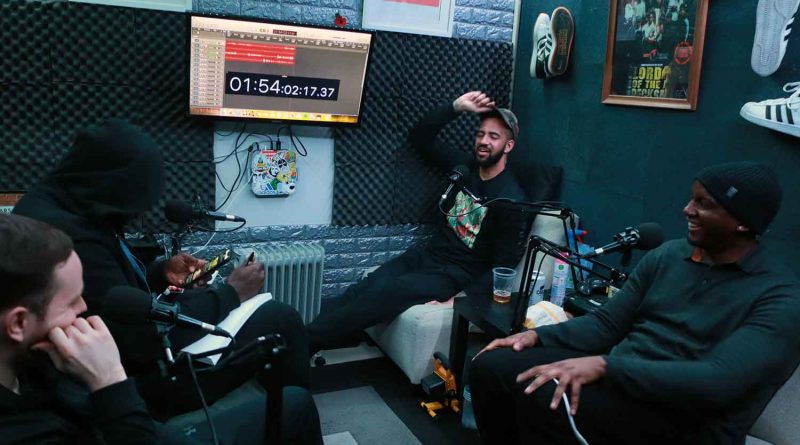‘Grime still gathers’: podcast hosts discuss the local music scene
Hosts of a new podcast inspired by the local music scene talk to us about growing up with the legends of grime and why the genre is here to stay.
It’s 2020 and grime is a worldwide phenomenon. Stormzy is undeniably one of the most influential pop stars in the country with a global fanbase; Skepta’s Konnichiwa has won the Mercury Prize; and the characteristic 140 bpm and sub-bass sound has spawned grime sub-genres in countries as close to home as France and as far flung as South Korea.
Back home, nestled in a recording studio a stone’s throw away from Bow E3, hosts Jay Bits, Jack Gipson, Antoine Lambert, and their producers, gather to record the eighth episode of their podcast Bits of This, Bits of That: which is heavily inspired by growing up around Roman Road and its surrounding areas in East London.
The podcast was the brainchild of Bits and Gipson, who have been talking on and off for two years about creating a show that’s about the music scene they’re involved in, but also not strictly restricted to just music.
‘There are tons of podcasts that are just about one thing,’ says Bits. ‘There are podcasts that are just about music, and ones that are just about sport or whatever. So I wanted to go straight down the middle.’ Hence the name, Bits of This, Bits of That.
Bits and Gipson found their co-host, Antoine Lambert, who also hosts his own music podcast, set them up with a studio in Leytonstone, and they recorded their first episode last November. Now 8 episodes in, they’ve just finished their first season.
The culture of the East London still permeates the podcast, from discussions about the media’s misunderstanding of grime’s clashing culture, to their guests – who are often from the local music scene. These include songwriter Jessica Agombar, who now works for Sony, and old school grime MC Armour.Jay Bits a.k.a Jason Balfourth and Jack Gipson were at the centre of the music scene when grime was still finding its sound, as a bunch of secondary school kids MCing in the basements and youth clubs of Bow.
The Bow music scene is something of a family affair for Bits – his father helped run Rinse FM – the now-infamous pirate radio station credited with popularising grime. Nowadays Rinse FM is more of a legitimate affair, but back then, it was mysteriously broadcasting from one of the tower blocks near Campbell Road since 1994.
‘So I was around pretty much around every grime MC you could think of now. From Wiley to Riko, DJ Slimzee, Tinchy, Ruff Sqwad, all of those sorts of people. I was around everyone. All before grime was even around or became a thing,’ says Bits.
Back then, a young adult Bits was rubbing shoulders with these DJs who would go on to be credited with creating a whole new genre. Gipson is younger at 24 years old, but they went to the same school.
‘We’re family,’ says Gipson. ‘Not by blood, but still family.’ Gipson is also the grandson of ‘Mr. Bow’ a.k.a Ray Gipson.
While Bits was more involved in the pirate radio end of the genre, Gipson was immersed in the the local youth clubs: the other element credited with creating grime’s distinctive trait: competitive MCing.
‘The youth clubs were the big hub for everything musical in all the area. So you would be part of the one club, you would go to different clubs, and clash there. It was a mad atmosphere because it would be people that you’d hate in day to day life you would go up against or work with,’ says Gipson.
‘And I was always at those youth clubs, where I was a sound engineer. I was always there, most nights. ‘Ten years on, many of these youth clubs no longer exist.
The particular one Gipson frequented, the Eastside Youth and Community Centre still exists under different management, and has recently hosted the Mad About Grime event.
But with the number of youth clubs halving over the last decade, Gipson and Bits reflect on how the loss of these community spaces, combined with technological advances, have inherently changed the original conditions that created grime.
‘The youth clubs were the element that brought everyone together as part of that MCing culture. So after they started shutting down, everyone sort of drifted,’ laments Gipson.
‘And it also used to be that before, only one or two people in the area had a recording studio. So everyone used to gather in those places. Now, everyone’s got their own equipment, and they can just make it from their bedrooms and just put it out there on the internet.’
‘There’s not much togetherness between the musicians who are now coming up,’ adds Bits. ‘There are still musical collaborations between artists. But before there was a sense of collaborative spirit. If you released a song, all the other artists would also lift you up. That doesn’t happen anymore.’
So the very physical spaces in Bow that shaped grime – the youth clubs, the streets which were setting of the music videos, and local record shops like Rhythm Division: hubs for artists to gather, have mainly gone.
Now, it seems that even the local artists are turning their eye to genre as a global phenomenon. For instance, Risky Roadz, a videographer who helped popularise many homegrown stars like Wiley, has produced a series called Grime Worldwide, looking at its sub-cultures around the world.
So has grime officially lost its local roots; no longer held down by a sense of place that spawned the genre?
‘Nah.’ Comes the resounding response from Gipson, Bits and even the other hosts who chime in.
‘No. No way.’‘It’s just gone to the masses,’ says Bits.
‘Yeah,’ agrees Gipson. ‘From that Risky documentary, even though it shows grime in South Korea, Russia, all these places, I still recognise the way they dress, the way they talk.’
Bits concludes, ‘Grime is more than music, it’s a culture. And so people from everywhere can relate, and we’re happy that’s being shared with everyone.’
And Gipson emphasises that there are still local grime artists who are still young, around his age, who are still making music closer to home.
‘People from around me growing up: Rascals, Lady Shocker, Villain and others,they’re still out there, making music. And they’re mainly people who’re big in these circles, to those in the know.’
‘Grime still gathers’, says Bits. ‘Sometimes. But we do.’


